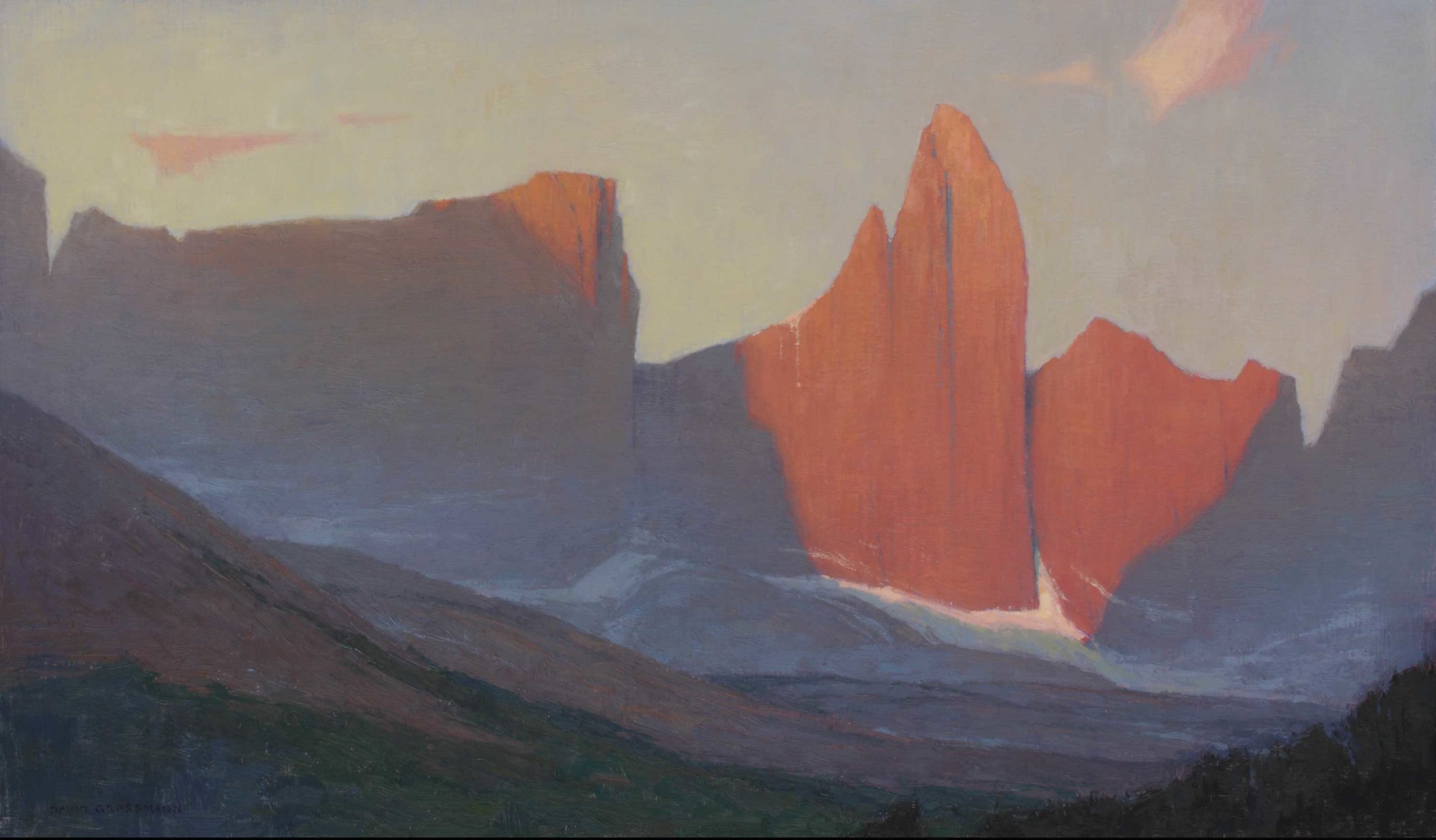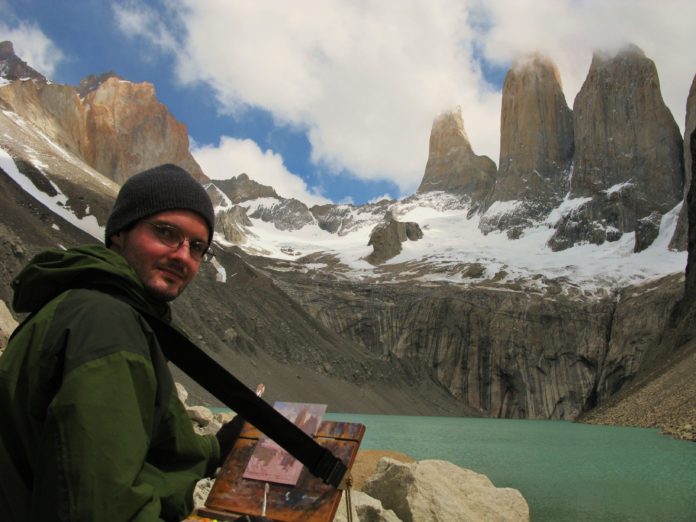Extreme Plein Air Painting > Come walk with me as I remember one of my dreams and how I chased it. It is a dream that led me, along with my painting gear, all the way to the southern tip of South America.
Plein Air Painting: Chasing Fragile Dreams
By David Grossman
It was a web of fragile dreams that led me here. In this place now I am the one who feels fragile, thrown and battered. Imagine the sound of ice cascading thousands of feet down rock walls. Imagine gusts of wind too strong to walk against, so strong that you have to sit down to keep from being blown over. Imagine torrential rain that comes and goes, and comes and stays, and stays. Imagine too the beauty of it, of condors catching the morning drafts of air, their shadows darting across cliffs turned gold by sunrise. Imagine the turquoise lakes, colored by glacial milk, swept with the endless currents of wind.

The dreams began when I was a boy. On the walls of my room were posters of things I thought were beautiful and places I dreamed of going—posters of wolves, of deer, of Mt. Everest and, my favorite, a poster of Torres del Paine National Park. The rock faces of the mountains glowed with the light of sunrise, reflected by the wind-swept lakes beneath them. The image epitomized beauty to me, the beauty of wild and solitary places, a tangible beauty that helped shape my love for mountains.
These are the iconic and remote mountains of Chilean Patagonia, now a UNESCO World Heritage site, and, despite their remoteness, a magnet for avid hikers from all over the globe. I remember well the photos of these peaks that I would pore over when I was younger—the sunrise so bright on the cliffs, and the guanacos (similar to wild llamas) posing so gracefully across the hilltops. I remember too the paintings that I did based on those photos, some of them when I was first learning to paint. And I remember the wistful, faraway dream that maybe some day I would stand there in person.

Twenty years later, I stand here in person. As I pause to catch my breath, my back aches from the extraordinarily large pack I am carrying. It was the biggest pack I could find, and in it I have my painting gear plus my supplies for eleven days of backpacking. It weighs more than 60 pounds, and I wobble a bit as I recommence the long upward climb toward my next painting stop.
On the slopes across the valley from me rise the strange forms of hanging glaciers. They cling to the slopes of the mountain in impossibly steep layers, massive and deep all the way up to the summit. The steepness of the terrain reveals the blue-green of the glacier’s deep recesses. Now and then the valley is filled with a sound almost like a jet plane flying overhead—a piercing, deep rumble. It is the hanging glaciers breaking off in chunks and flooding down the rock walls.
By now I have lost track of days. It seems that I exist in a place without time of day or days of week. It is just me, the views, my paintings, the weather, hunger, and how long before I can sleep again. It seems that I am praying constantly, maybe since there is no one else to talk to, and especially during the long hours when I am holed up in my tent as I wait for the rain to stop.

A Few Days Before
Again I awake at 3:25 a.m. (I was dreaming something about flowers—I was painting an arrangement of them indoors and someone was scolding me for being inside when there were such beautiful things to paint outside.) I am determined to paint the sunrise from the base of the towers today. The cold hits me as soon as I roll out of my sleeping bag, and it spurs me quickly up the winding trail. Above me a few stars linger through the misty cloud layer. There is a fresh dusting of snow on the mountains; at first light they look like a black and white image. I have the sense that I am climbing up into a perfectly exposed Ansel Adams photo.

Soon I am walking through a crusty layer of new snow. The towers are clear, so my hopes remain high for a good sunrise. I set up my equipment and begin to paint. A few brushstrokes, and it starts to snow. The wind spews flurries of freezing pellets across the landscape and into my paint. Quickly I gather my things and scurry down to the shelter of a large boulder next to the lake. The rock mostly blocks the wind, so I am secure enough to complete the painting. I remind myself, as I have over and over again during this trip, that at this point some things are not optional. That thought helps to keep me going.
The sunrise is mostly blocked by falling snow, but that in itself is stunning. At a glance the clouds are deep cobalt here and warm ochre there. Once I have finished the painting I am too cold to stay any longer and the towers are covered completely in clouds. On the way back down the steep, icy trail, I walk slowly, soaking in the beauty of the snow-capped peaks and giving thanks for being here and for being alive on such a day as this.

Epilogue
A few days after my return from Torres del Paine, I see another image that is almost identical to my childhood poster. It is a news photo of the same mountains, from nearly the same vantage point, but my mountains are obstructed by thick columns of smoke. Other images follow: firefighters rushing in to contain windswept flames, helicopters hovering over the alpine lakes, wild animals fleeing. In the end, the massive forest fire—thought to have been started by a negligent hiker—consumed over 40,000 acres of the park’s pristine landscape.
As I ponder these images, I gather my memories, my sketchbook, along with the many plein air pieces I painted in Torres del Paine, and begin to paint again.
The finished product is a series of paintings that are a commemoration of the beauty and vulnerability of the Patagonian wilderness. Several of these paintings are inspired by the sun rising on the steep rock formations. There is something poignant to me about sunrises and sunsets because they remind me of how fleeting time is and how quickly everything changes. The sunrise makes for an interesting parallel with the permanence of the mountains, casting its light on the vulnerable beauty of dreams and of wild places.

The above article on plein air painting in South America was originally written and published in 2013.
Learn more about David Grossman at: www.davidgrossmann.com
Visit EricRhoads.com to find out all the amazing opportunities for artists through Streamline Publishing, including:
– Online art conferences such as Plein Air Live
– New video workshops for artists
– Incredible plein air painting retreats
– Educational and fun art conventions, and much more.
> Subscribe to Plein Air Today, a free newsletter for artists
> Subscribe to PleinAir Magazine so you never miss an issue





